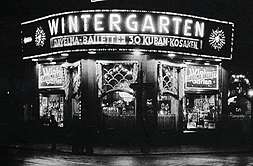Home > Fashion in Weimar Germany
Fashion in Weimar Germany
Leave your troubles outside!
So- life is disappointing? Forget it!
We have no troubles here! Here life is beautiful...
The girls are beautiful...
Even the orchestra is beautiful! (1)
It is Germany, 1928. Raucous laughter from the cabaret seeps outside as Lotte passes in the shadows of the cold Berlin night. The streets are sexually charged, lined with a heady concoction of prostitution, homosexuality, transvestism and drugs. Still spinning from the collective lust roaring unashamedly through the theatre that evening, Lotte heads now for the café bar at the Eden Hotel where she lives. Jostling with leggy glamour girls as she takes her drink, Lotte pushes a straying strand of short hair behind her ear, settles her slender trouser-suited body into the deep folds of an armchair and smiles provocatively as she lights a cigarette.
 Berlin's interwar reputation of hedonistic decadence and debauchery
is familiar through scenes from Metropolis by Fritz Lang, images
of Marlene Dietrich in The Blue Angel by Josef von Sternberg and
stage productions of The Threepenny Opera by Bertolt Brecht. A ferment
of artistic and sexual experimentation, the Weimar Republic (1918-1933)
privileged an outpouring of cultural creativity in the Bauhaus movement
of modern art and the development of the International Style in
modern architecture. Against a background of inflation and depression,
Berlin drew the talent and energies of the rest of Germany towards
its glittering cabaret performances and burgeoning sex tourism industry.
From within this hotbed of frenzied immorality, supposedly constitutional
sexual equality worked to create the myth of the sexually liberated
and financially independent 'New Woman' in Weimar German society.
Berlin's interwar reputation of hedonistic decadence and debauchery
is familiar through scenes from Metropolis by Fritz Lang, images
of Marlene Dietrich in The Blue Angel by Josef von Sternberg and
stage productions of The Threepenny Opera by Bertolt Brecht. A ferment
of artistic and sexual experimentation, the Weimar Republic (1918-1933)
privileged an outpouring of cultural creativity in the Bauhaus movement
of modern art and the development of the International Style in
modern architecture. Against a background of inflation and depression,
Berlin drew the talent and energies of the rest of Germany towards
its glittering cabaret performances and burgeoning sex tourism industry.
From within this hotbed of frenzied immorality, supposedly constitutional
sexual equality worked to create the myth of the sexually liberated
and financially independent 'New Woman' in Weimar German society.
Born out of Germany's disastrous defeat in World War I, the Weimar Republic exercised democracy amidst continuing chaos and political upheaval. Economic crisis followed the devaluation of the German Mark in wake of the undermining of payments demanded in the Versailles reparations clause imposed on Germany at the end of World War I. The political and economic collapse resulted in the "destruction of the inherited framework of beliefs and certainties which had given Germany its particular reassurance" (2). Unable to maintain the image of a strong, victorious Reichswehr, or Reich Defence, former Imperialistic values of hard work and national pride were subsumed in the emergence of a new decadence and urban proclivity.
The socially correct role of women was similarly transformed in face of the erosion of old traditions and moral principles. In the 19th century, Kaiser Wilhelm II had defined women's position in society as centering on the 'Kirche, Kueche, Kinder', or church, kitchen and children. After the adoption of the Weimar Constitution in 1919, women were guaranteed a new status of equality with men in terms of their enfranchisement and legal and economic standing. However, these advances were little more than token gestures of appeasement. The 1919 Constitution was never enforced through legislation, and the Kaiser's restrictive Civil Code of 1900 continued to control the legal and financial rights of women. As the historian Claudia Koonz states, "[the] Weimar leaders grafted a democratic state onto a traditionalist and conservative social structure and a thoroughly capitalist economy" (3).
Nevertheless, the myth arose of a 'New Woman' challenging men in the realms of politics and economics. Mass advertising in the Popular Press capitalized on the power of this image in selling branded products and promoting specific lifestyle choices. A magazine article from the period described the new generation of women, claiming "They go to the cinema in the evenings, wear skirts that end above the knees, buy 'Elegant World' and the film magazines" (4). Portrayed in films, newspapers and Pulp fiction, the 'New Woman' was typically depicted as a sexual object for the satisfaction of male desire. Sexually predatory and educated, she achieved financial independence through employment and spent her earnings on fashion and fun. She had short bobbed hair, wore relaxed masculine clothes, smoked cigarettes and enjoyed the globally notorious nightlife of Berlin's theatres, cinemas, cafes and bars. According to the historian Ute Frevert, the Weimar women were "children of the new age who were variously celebrated or accursed" (5).
Despite their apparent emancipation from oppressive tradition, they were feared by the older generation for their individualism and selfishness. Much of this fear lay in the promulgation of a childbearing strike by the Syndikalistische Frauenbund or SFB (Syndicalist Women's Union), established in 1920. An article written in 1921 stated that "the advancement in the intellectual development of women [could] not be possible without the liberation from the slavery of childbearing" (6). Accordingly, many young women campaigned at public rallies, calling for the criminalization of contraception (paragraph 184.3 of the Constitution) and the prohibition of abortion (paragraph 218) to be revoked. However, these moves towards allowing women the possibility of legitimate birth control were deemed inherently selfish rather than sexually liberating in light of the falling birth rate and depleted population at the end of World War I.
In general therefore, the 'New Woman' was represented negatively and blamed for the degeneration of Weimar society and culture. However, the reality of life for the majority of women in the Weimar Republic was vastly different from that of the 'New Woman' they avidly desired to emulate. Confronted by exploitation and underpromotion in the workplace, many women continued to embrace the 'Kinder, Kueche, Kirche' ideal of the former monarchy. Notions of political liberation were also tenuous. Despite enfranchisement in 1918, their representation at all levels of Weimar German political party leadership was minimal. It is therefore an inescapable conclusion that depictions of the 'New Woman' were media-generated and founded in male constructions of sexuality that reflected the underlying social, economic and political insecurities and anxieties of the era. Indeed, the very popularity of misogynistic and distorted images of the 'New Woman' among women themselves reveals the impossibility of their liberation at even the level of being able to reject their own stereotypical depiction.
Notes
(1) From Cabaret, music by John Kander, lyrics by Fred Ebb. Carlin
Music Corp., 1967.
(2) de Jonge, A. (1978) Weimar Chronicles, New York, Paddington
Press Ltd., p. 13.
(3) Koonz, C. (1987) Mothers in the Fatherland: Women, the Family
and Nazi Politics, New York, St. Martin's Press.
(4) Wehrling, T. (1920) 'Berlin is becoming a whore' in Das Tage-Buch.
(5) Frevert, U. (1989) Women in German History: from Bourgeois Emancipation
to Sexual Liberation, New York, Berg.
(6) Wittkop-Rocker, M. (1921) 'Frauenarbeit Frauenorganisationen'
in Der Frauenbund, Monatsbeilage des Syndikalist , 1, October.



